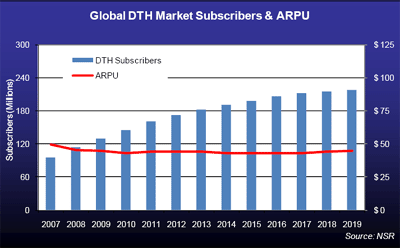|
It goes without saying that Direct-to-Home (DTH) is perhaps the most customer-centric of all satellite industry segments. It remains the largest B2C application for satellite capacity and one that continues to cross borders, cultures and income levels the world over.
For the most part, DTH businesses rely on acquiring subscribers and raising ARPU with premium services to achieve profitability. On the cost side, key parameters include subsidies on STB equipment, transponder leases and finally the cost of content that invariably varies across countries. A lot depends on the channels that are bought by the platform, and new players end up paying a lot more per subscriber for the channel. The only other option for them is to pay a huge lump sum until they reach a minimum number of subscribers, which translates into a huge fixed cost.
Dish Network and DirecTV in the U.S. both achieved profitability close to 7 years in operation at a penetration of approximately 7% of television households. Ceteris paribus it has been observed that these benchmarks generally hold true for the vast majority of DTH markets the world over.
For most platforms in Central & Eastern Europe, the magic number averages close to the 500,000 subscriber mark. A look at individual countries reveals that for Romanian platforms the figure stands at about 300,000 subscribers, whereas for Ukraine it could be as low as 100,000 subscribers to achieve profitability. Platform N, based in Poland, is yet to achieve breakeven despite crossing the 700,000 subscriber mark last year. It is largely understood that the cost of providing relatively advanced equipment has kept them from turning profitable. Other platforms in the country such as Cyfrowy Polsat and Cyfra+ managed the same feat with anywhere between 400,000 and 600,000 subscribers after a mere 5 years in operation.
In South Asia, Dish TV is first in line to breakeven, and although they have crossed the minimum base of about 6 million subscribers required to turn cash flow positive, operational profitability is still a couple million subscribers away. Indian operators are plagued by costs of acquisition, which are nearly two times the average revenue per subscriber on an annual basis. The business model for all operators pegs content cost at about 50%-60% of total operational cost as is evident from Dish TV’s published data. Despite this fact, as penetration for the leading platform reaches to about 7% of the country’s television households, their balance sheets are looking much healthier.
Brazil’s DTH operators are closing in on profitability depending on their business plan, but as a benchmark they need about 1.5 million subscribers (at a minimum) to be profitable. In other parts of Latin America such as Chile, breakeven is at about 50,000 subscribers per transponder, at which point the satellite cost per customer falls to less than 10% of ARPU. In Peru the minimum number of subscribers required to breakeven is about 200,000. Again, on an average, most companies are targeting profitability within the next 3-5 years at about the same level of penetration.
So What Does This Mean for New DTH Operators?
As shown in the figure below, DTH subscriber growth continues to be healthy for the industry at large, and NSR expects the numbers to scale well over 200 million by 2019. However, ARPUs are being pulled downward by the millions of subscribers that continue to be added in South Asia and Central Europe at single-digit ARPU levels.

Emerging operators in South Africa have based their business models on breakeven at about 300,000 subscribers over 3 years. This again translates into roughly 6.7% of television households in the country. Although Africa may prove to be more of a challenge given the dominance of the incumbent provider, NSR believes that operators will be able to find their niche in one of the fastest growing television markets in the world.
Towards the 2012 to 2015 timeframe (i.e. between the London and Rio Olympics), NSR expects that Premium services such as HD and DVRs will have made it easier for platforms in most countries to achieve profitability. ARPU levels will stabilize, although it may take a while before they show any signs of growth. Nonetheless, profitability will come in the form of a smaller percentage of subscribers paying more for better quality services.
|